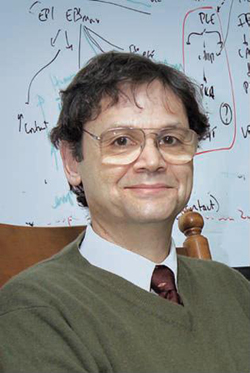 |
Stephen Rennard, M.D. |
“The university-wide awards recognize faculty whose research and teaching have made an impact on students, the university and the state,” said University of Nebraska President James B. Milliken. “The strength and reputation of any university depends on the quality of the faculty, and we have some of the best in the country on our four campuses.”
In nominating Dr. Rennard, Tom Rosenquist, Ph.D., wrote that Dr. Rennard is driven by compassion, curiosity and a desire to challenge and advance knowledge.
“These traits make Steve Rennard both an outstanding researcher and an engaging, benevolent human being,” said Dr. Rosenquist, UNMC vice chancellor for research. “He truly is the best of the best.”
Below is a portion of a UNMC Discover article written in 2007 featuring Dr. Rennard after he was named UNMC’s first scientist laureate.
Obsessed with Addiction: UNMC’s first Scientist Laureate never quits
by Elizabeth Kumru
Colleagues call him brilliant, thoughtful, creative.
At UNMC, he’s the best of the best researchers and he’s set himself a mighty task.
Stephen Rennard, M.D., one of the world’s foremost experts in pulmonary and critical care medicine, wants to cure the incurable.
“It’s unsatisfying for patients to seek treatment for which there is no cure. People are still dying from asthma and chronic obstructive pulmonary disease (COPD). I want more for my patients,” he said.
The mysteries of such lasting diseases as asthma and COPD weigh heavily on Dr. Rennard’s mind. COPD ailments include emphysema and chronic bronchitis, the fourth leading cause of death in the United States.
UNMC’s first Scientist Laureate wants cures.
As a physician, teacher and storyteller, Dr. Rennard takes clinical problems and asks important basic research questions.
“He’s unique in that he can see the forest and the trees,” said Lynell Klassen, M.D., chairman of internal medicine. “Most researcher/clinicians can only see one or the other. He asks specific questions that are important to the whole biologic picture.”
“He also models characteristics I would love our scientists to have more of — inquisitiveness, and an ability to ask thoughtful questions, then put answers into the larger picture of biology and clinical care.”
|
“He thinks about problems differently from anyone else. There are two things we think about — innovation and significance. He excels in both. We are especially fortunate to have Dr. Rennard at UNMC because of his leadership, scientific innovation and worldwide reputation as a lung clinician and scientist. He has an encyclopedic memory and is a real superstar in pulmonary research.”
Dr. Rennard’s basic and clinical research takes him many directions at once, from the mechanisms of what causes disease and the subtleties of prevention to the methods for developing cures and implementing disease management programs. He’s been innovative in developing novel approaches to research in inflammatory airway diseases, fibrosis and lung stem cell biology, and in clinical care for COPD, smoking cessation, asthma and bronchitis.
He currently juggles about $4 million in annual research funding from various contracts and grants, including one from the National Institutes of Health. (EDITOR’s NOTE: These are 2009 numbers.)
He’s called on to present, serve and consult at national and international meetings, committees and foundations and has been asked to present medical grand rounds at universities throughout the country. More than one-third of his year is spent traveling. Even his legendary research on his wife’s grandmother’s chicken soup recipe continues in one part of his laboratory in the Durham Research Center.
“The project is too much fun to drop,” he said.
Despite its controversial nature, embryonic stem cell research is one of the new challenges in which Dr. Rennard sees great promise. He’s created a mouse model that shows embryonic stem cells can form cells that may repair lung tissue damaged by emphysema.
“Good research should be controversial because it challenges conventional wisdom,” Dr. Rennard said.
Among the activities of which he is most proud are the recent smoking bans in Nebraska. As soon as he arrived in Nebraska from the National Institutes of Health, he was asked to testify before the Omaha City Council on the hazards of secondhand smoke and began lobbying for a smoking ban in bars and public places.
More than 20 percent of adults smoke, and it is the single most important cause of preventable deaths in the United States.
The breadth of Dr. Rennard’s research into treatments for smoking has included nicotine vaccines, alternative tobacco products and products to help people stop smoking, many of which are now on the market. He has written many articles on smoking cessation and was the lead author for the smoking cessation section of the COPD guidelines of the American Thoracic Society.
So, what drives this man of excellence? For this voracious reader, a lover of mysteries and a student of mythology — the answer may lie in literature.
He’s asked, “What was your favorite book as a child?”
Pressing his fingers and thumbs together to form a triangle, Dr. Rennard searches his memory while rocking in a chair that once eased newborns to sleep in the University Hospital nursery more than two decades ago. A father to eight and grandfather to seven, the motion is as familiar as it is comfortable.
“It was the ‘Little Engine That Could.'”